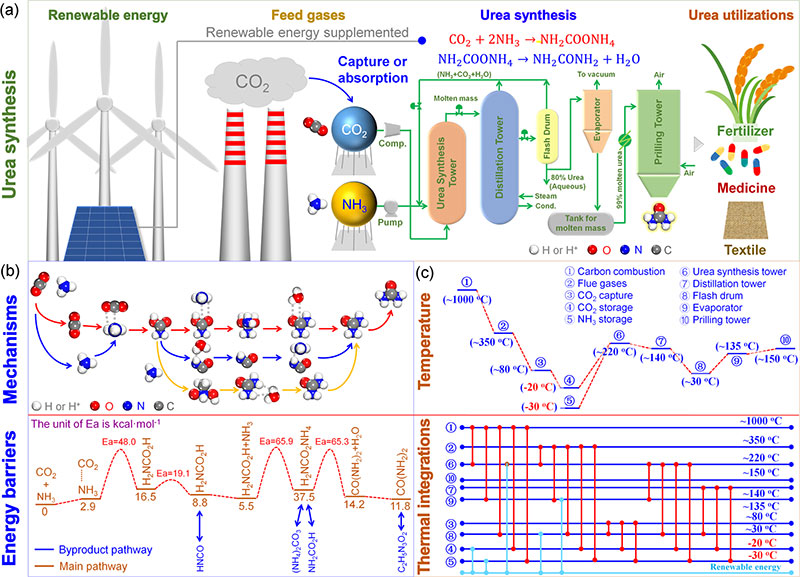The ammonia required for the synthesis of urea is synthesized via a lithium-assisted electrochemical reaction, the cells are equipped with nickel electrodes and using a solution based on graphene and LiNTf2 - bis(trifluoromethane)sulfonimide.
The reaction starts directly from atmospheric nitrogen and water and is powered by renewable energy with a CO2 based storage system.
Once ammonia has been produced, urea is synthesized using the Bosch-Meiser process. This is based on the synthesis of ammonium carbamate from carbon dioxide and ammonia and the subsequent decomposition reaction of the carbamate providing urea and water:
2NH3 + CO2 —> H2N−COONH4 —> (NH2)2CO + H2O
The formation of urea from elements is an exothermic process with ΔfH° < 0 and an exergonic process with ΔfG° < 0.
The process involves two equilibrium reactions:
- in the first phase the liquid ammonia reacts with carbon dioxide producing ammonium carbamate,
- in the second phase there is an equilibrium reaction in which the ammonium carbamate decomposes into urea and water.
In the first phase the ammonia reacts with the CO2 stored in the accumulation system, while in the second phase we have a fixed bed reactor with a membrane system for capturing the reaction water, moving the entire reaction to the right. Furthermore, a urea separation system is foreseen with the compounds that have not yet reacted: these will be reintroduced into the production cycle.
The reaction has several complex aspects:
- The reaction is governed by an equilibrium that requires the removal and recycling of the reactants not transformed into urea.
- Temperatures and pressures are quite high.
- The solutions are very corrosive.
- The physical and chemical characteristics of solid urea are fundamental.
- A poorly run urea plant can become a source of air and water pollution.
With our technology all the problems listed above are constantly monitored and managed by providing high quality solutions.
The stripping of ammonia takes place inside a special controlled cavitation reactor capable of significantly improving the production process as well as preventing the reformation of ammonium carbamate.
High process efficiency (low consumption of raw materials, low energy requirement). Sustainable environmental pollution and a high quality product.
Furthermore, thanks to this innovative process developed by us, the systems can be extremely compact, eliminating the need for mega centralized production structures.
A further strong point of this system is that it does not produce greenhouse gases but, on the contrary, consumes considerable quantities of carbon dioxide with consequent production of water.
The environmental impact of this system is below zero and therefore can be fully classified as climate-friendly: the net production of carbon dioxide or other greenhouse gases is less than zero given the consumption of carbon dioxide for the process.











